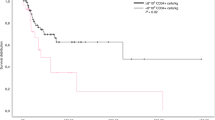Summary
Colony-stimulating factors (CSF) are frequently used in cases of cytostatic therapy of patients with testicular cancer assuming that they support hematopoietic recovery and, thus, shorten duration of neutropenia as well as reduce infections. Currently, G-CSF and GM-CSF are clinically used. In the present study efficacy and toxicity of these two drugs were investigated and compared in patients with testicular cancer treated by standard chemotherapy. Studying 83 chemotherapy cycles applied to 31 patients with advanced germ cell tumors the effectivity and the side effects of the two CSF were examined by questioning, clinical evaluation, and blood chemistry studies. G-CSF (480 μg subcutaneously (sc)) were used in 55 and GM-CSF (400 μg sc) in 28 chemotherapeutic cycles. The indications consisted in the treatment of leukocytopenia on the one hand and in the prophylaxis in subsequent cycles on the other hand. No difference between the two CSF could be found either with regard to postponement of the next cycle (G-CSF: 6.8 vs. GM-CSF: 7.3 days), or to the number of injections per cycle (G-CSF: 8 vs. GM-CSF: 12.5), or to the leukocyte (G-CSF: 2.1 vs. GM-CSF: 1.6 × 103/μl) or platelet nadir (G-CSF: 0.5 vs. GM-CSF: 0.5 × 105/μl; mean values of all cycles, respectively). Both CSF did not seem to influence the production of platelets. However, a difference between the two CSF was demonstrated with respect to the toxicity. Frequency (G-CSF: 38.5 % vs. GM-CSF: 69.3 %) as well as intensity of side effects causing a change of the drug (G-CSF: n = 1 vs. GM-CSF: n = 7) were lower in the case of G-CSF. In conclusion, these data demonstrate no difference was seen between G-CSF and GM-CSF with respect to the efficacy in patients with testicular cancer treated by standard chemotherapy. However, the use of G-CSF seems to be associated with lower toxicity.
Zusammenfassung
Koloniestimulierende Faktoren (CSF) werden heute häufig bei der Chemotherapie von Hodentumoren eingesetzt, da es als erwiesen gelten kann, daß dadurch ein zeit- und dosisgerechterer Ablauf der zytostatischen Behandlung erfolgen kann. Im klinischen Einsatz befinden sich derzeit der Granulozyten-Kolonie-stimulierende Faktor (G-CSF) und der Granulozyten-Makrophagen-Kolonie-stimulierende Faktor (GM-CSF). In der vorliegenden Untersuchung werden die Wirksamkeit und das Auftreten von Nebenwirkungen der beiden Substanzen bei einer Standardchemotherapie von Hodentumoren überprüft und miteinander verglichen. Anhand von 83 Chemotherapiezyklen, die bei 31 Patienten appliziert wurden, wurde mit Hilfe von Anamnese, klinischer Befunderhebung und Laborkontrollen die Effektivität und Toxizität der beiden CSF untersucht. Dabei kam G-CSF (480 μg subkutan (sc)) bei 55 Zyklen und GM-CSF (400 μg sc) bei 28 Zyklen zur Anwendung. Die Indikation bestand einerseits in der Behandlung einer Leukozytopenie, andererseits in deren Prophylaxe bei den nachfolgenden Zyklen. Weder bei der Zyklusverschiebung (G-CSF: 6,8 vs. GM-CSF: 7,3 Tage), noch bei der Anzahl der Injektionen (G-CSF: 8 vs. GM-CSF: 12,5) noch bei dem Leukozyten- (G-CSF: 2,1 vs. GM-CSF: 1,6 × 103/μl) bzw. dem Thrombozytennadir (G-CSF: 0,5 vs. GM-CSF: 0,5 × 105/μl; jeweils Mittelwert aller Zyklen) war ein Unterschied zwischen den beiden CSF zu beobachten. Beide CSF schienen keinen Einfluß auf die Thrombozytenbildung aufzuweisen. Hingegen war bezüglich der Toxizität eine deutliche Differenz zwischen den beiden CSF nachzuweisen. Sowohl die Häufigkeit (G-CSF: 38,5 % vs. GM-CSF: 69,3 %) als auch die Schwere der Nebenwirkungen mit der Notwendigkeit des Umsetzens des Präparates (G-CSF: n = 1 vs. GM-CSF: n = 7) war bei G-CSF deutlich geringer ausgeprägt. Schlußfolgernd ist somit festzustellen, daß bei der Anwendung der beiden CSF bezüglich der Wirksamkeit auf die Leukopenie nahezu kein Unterschied nachweisbar war. Es scheint jedoch bei Anwendung von G-CSF eine niedrigere Nebenwirkungsrate aufzutreten.
Similar content being viewed by others
Author information
Authors and Affiliations
Rights and permissions
About this article
Cite this article
Will, R., Hofmockel, G., Langer, W. et al. Use of colony-stimulating factors (CSF) during chemotherapy of patients with testicular cancer. A comparison between G-CSF and GM-CSF. Urologe [A] 38, 258–263 (1999). https://doi.org/10.1007/s001200050278
Issue Date:
DOI: https://doi.org/10.1007/s001200050278




